This post is also available in: Español (Spanish) Kreyòl (Haitian Creole)
The parties went until 5 or 6 a.m., two or three times a week. Sometimes, after leaving the party, Didier Chan would go straight to class, still wearing the green sequined shirt he had worn to the party. However, Didier attended the parties not to dance or celebrate, but to work. He played the keyboard and was the backup singer for the band Bombazo Musical, a job that allowed him to pay for his college education.
“I often went to school in my band attire, half asleep. I carried my backpack to my gigs and my keyboard to school,” Didier recalls with a laugh. It was 2009, and he was taking Linguistics and Maya Culture at Universidad de Oriente in Valladolid. There, Didier Argelio Chan Quijano, now 36, dreamed of preserving the Yucatec Mayan language in southeastern Mexico, a linguistic variant known as Maayat’aan.
A dream involves coming up with a wish. It demands imagining that you can be in a world beyond the circumstances threatening you, on a new horizon. And the fact is that the decline of the Mayan language in Yucatán was a matter of great concern. According to Mexico’s National Institute of Statistics and Geography (INEGI), 29.6% of Yucatecans spoke the language in 2010, but this percentage dropped to 23.7% by 2020. This decrease represents a “medium risk of the disappearance” of Maayat’aan (Yucatec Mayan), according to Mexico’s National Institute of Indigenous Languages (INALI). Statistics indicate that language loss occurs not only in adults, but also among youths and children, as a matter of greater concern. And when new generations do not speak the language, it is at risk of disappearing.
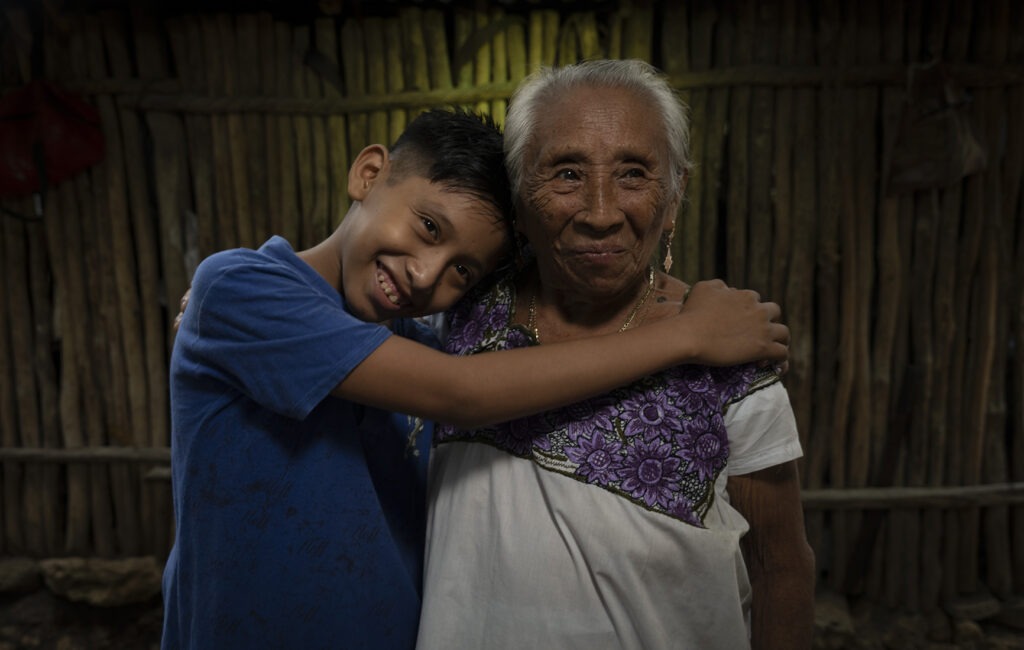
Táan u méek’ik u ka’achiich tumen leti’ u mootsil le t’aano’ ([Rodolfo] hugs his 88-year-old great-grandmother, [Anastacia], whose soul is the very root of the language).
***
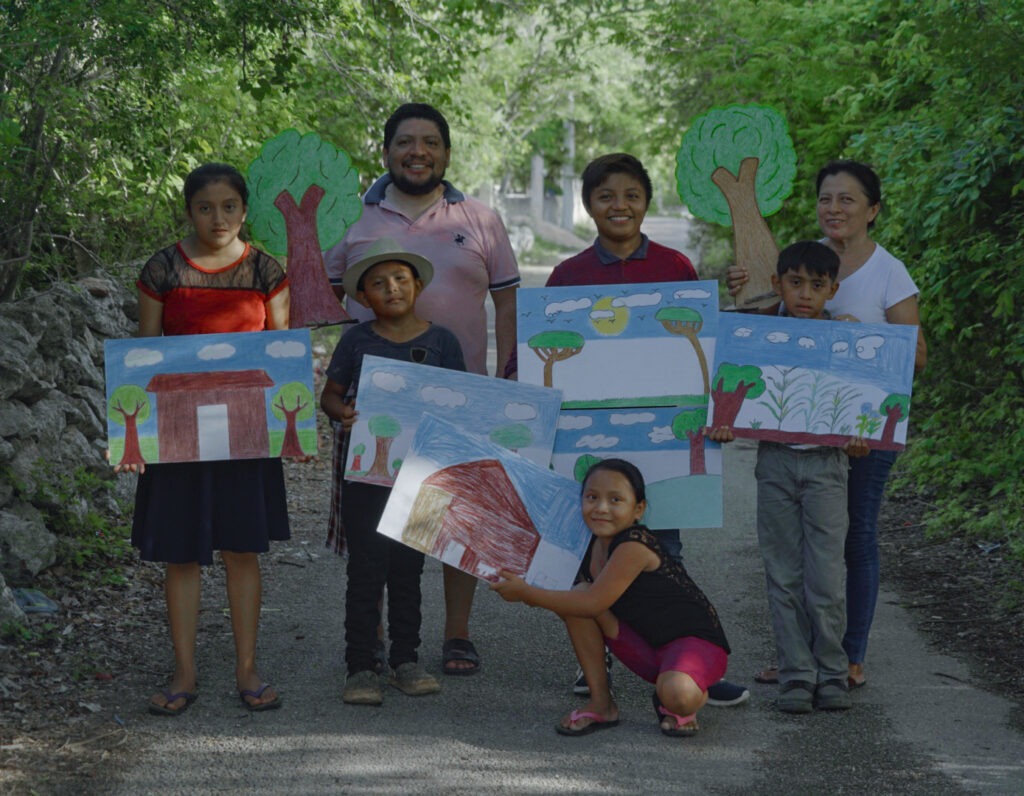
Leti’ob yéetel tene’, táan ik bonik u beejil uti’al u kuxtal maaya t’aan (We are painting the path to revitalizing the Mayan language).
Didier imagined his dream and the way to get there. First, and very intuitively, he added Mayan songs to the Bombazo Musical repertoire. Some of the songs he composed became a hit every night. He then participated in an academic research project and taught Mayan language classes to hundreds of students. He recently turned to digital activism with children and adolescents.
He was one of the beneficiaries of the Rising Voices program, the global initiative that gives $2,500, as well as support and mentorship, to local actors from small communities to preserve Indigenous languages through digital tools. Rising Voices began to support digital activists of various Indigenous languages in Latin America in 2014. In recent years it has focused on encouraging the participation of local actors speaking Mayan languages in southern Mexico, incorporating them into broader networks of activism in the region.
In 2022 and 2023, Rising Voices awarded 20 microgrants to fellows in the Yucatán Peninsula and Chiapas through the Mayan Languages Digital Activism Fellowship Program. Lorenzo Itzá, one of the organization’s coordinators in Mexico, explains that the projects include community radio broadcasts, sign language lessons, podcast production, the creation of digital books, and literacy. Those selected are accompanied throughout the program by two community mentors who use individual online sessions to guide them in achieving their goals. Itzá adds that these sessions are followed by two virtual group sessions held each month to share the progress made. “They are knowledge exchange sessions, where you share what you know about software, teaching methodologies, the use of Adobe, video editing or whatever you know,” says Itzá.
Last January, the program held the first Mayan Languages Digital Activism Summit in Mérida, with lectures, conferences and workshops scheduled for the beneficiaries and guests over five days. Sasil Sánchez Chan, the other coordinator of Rising Voices in Mexico, explains that this is how they are learning and forming networks and a support community that will make it easier for these digital activists to continue with the projects on their own once the program is completed. Didier sees that the group sessions and the summit not only helped him learn from his peers about a tool that is useful for his work but also helped him learn that he is not alone and that other people like him are concerned and dedicated to preserving the endangered Indigenous languages.
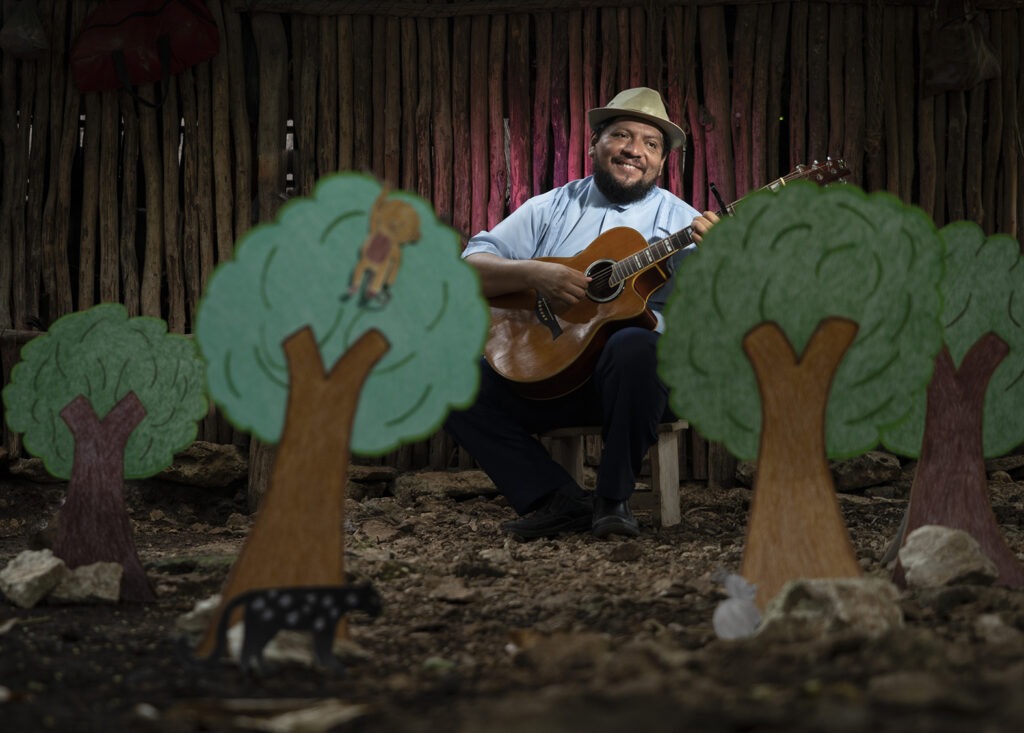
Didier sings the verses of his songs in the Mayan language: “K’aay yéetel paax, u ja’il uti’al u jóoyabta’al maaya t’aan,” [Singing and music, water that nourishes the Mayan language], an allusion to their work revitalizing their mother tongue.

In his performance of the song In waalak’ peek’ (My Dog), Didier sings along with the girls and boys of his collective, “Yaan ten tin wotoch, juntúul in waalak’ peek’, sáansamal kin ts’áaik u yo’och , tumen ku kanáantiken” (I have a dog in my house; I feed him daily because he cares for me).
***
Tixhualactún is a quiet little town in the municipality of Valladolid, where Didier began the project. In the afternoons, the children play in the public park, the women talk on the benches outside the grocery stores or their homes, and the men gather on the esplanade after eight at night, after working in the fields.
On the walls and posts of those spaces and amid the laughter of children and the murmurs of women, Didier publicized his idea with posters and a megaphone: “We are looking for kids who want to tell stories in Mayan! We are looking for kids who want to tell stories in Mayan!” Fredy, who is 12 years old, had been sent by his parents to pay the light bill. He was walking by Didier and his wife, Sánchez Tuz, on the esplanade when he became curious and stopped to ask for information. He then went home to ask permission.
His name is José Alfredo Uicab, but everyone calls him Fredy. This June 27, he appears along a dimly lit path, surrounded by vegetation. “Every time we see him, he’s running an errand,” Didier jokes when he finds him with a bag of eggs and milk for dinner. Fredy gets shy and hides behind his mother, from whom I ask permission to interview both of them.
“What time would it be?” asks Cecilia Choc, the mother, about the interview.
“Around six. Is that time good for you?” I ask Fredy.
“Yaan in bin xook,” Fredy whispers in Mayan, holding onto the skirt of his mother’s hipil (traditional Yucatecan dress).
“He says that he goes to school at that time,” interprets Cecilia.
“No, but 6 p.m.”
“Ohhh,” he says, relieved, nodding his head yes.
The answer is surprising. When Didier and Fredy met a year ago, he avoided speaking Mayan, something common among the new generations, who prefer Spanish. Now, he speaks it daily, at least with his family. Didier gave them brief Mayan lessons and encouraged their use among them so they normalized it and knew they could share it with other children because the language that is not spoken dies. “What they were missing was the social use of Mayan,” says Didier.
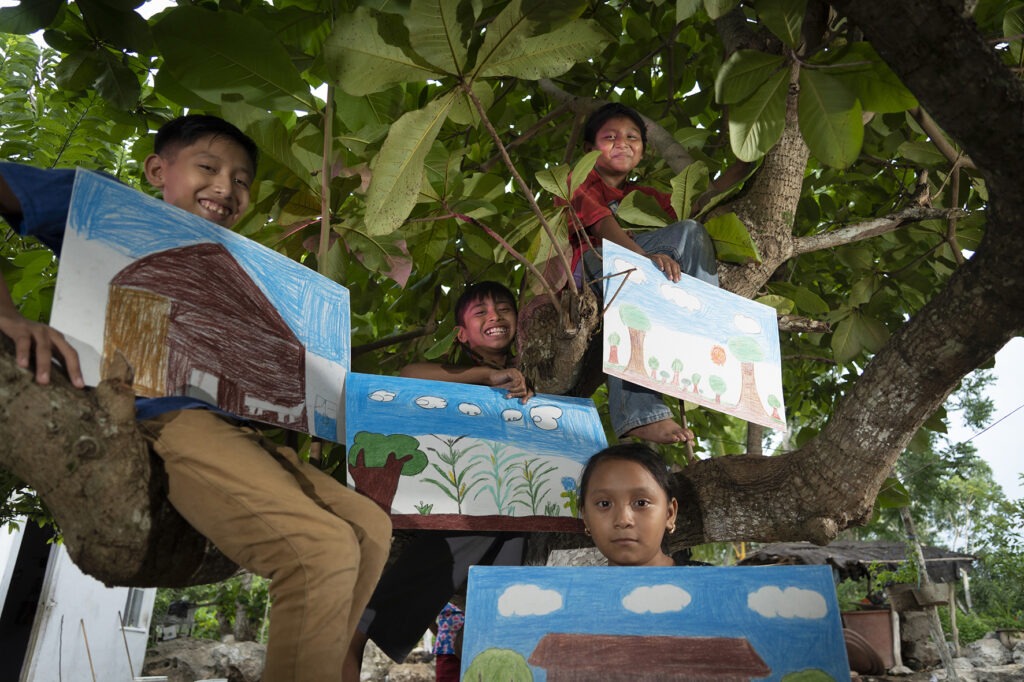
Rodolfo (left) drew “U naajil u chiich” (Little Red Riding Hood’s grandmother’s house). José Alfredo “Fredy,” at the top of the tree, shows his drawing of the K’áax (mountain) as part of his story titled Juntúul chan peek’ (A Little Dog). José “Chucho” (center) drew ichkool (cornfield). His story, titled “kéej yéetel t’u’ul” (The Deer and the Rabbit), and Blanquita shows the drawing, “Xa’anil naj” (The House made of Guano), by her classmate Ángela.
The Mexican State erased the different native languages through its miscegenation policy. Although Mexico’s Federal Constitution requires promoting Indigenous languages, and the Congress of Yucatán passed a law making it mandatory to teach the Mayan language in basic education and declare it an Intangible Cultural Heritage, in 2019, it is the efforts of young people like Didier that engage the population in the recovery of their language.
In the first part of the project, Didier asked Fredy and the other four boys to bring a story from their community or relatives. Something that he thought was simple became a problem. “We realized that stories are no longer told here,” says Adriana Sánchez, also a linguist. Since Fredy’s Mayan was not fluent, they gave him a short story, “about a dog that gets lost in the mountains and reappears after some time,” Fredy said. “They gave him water and tortillas. And that’s where it ends.”
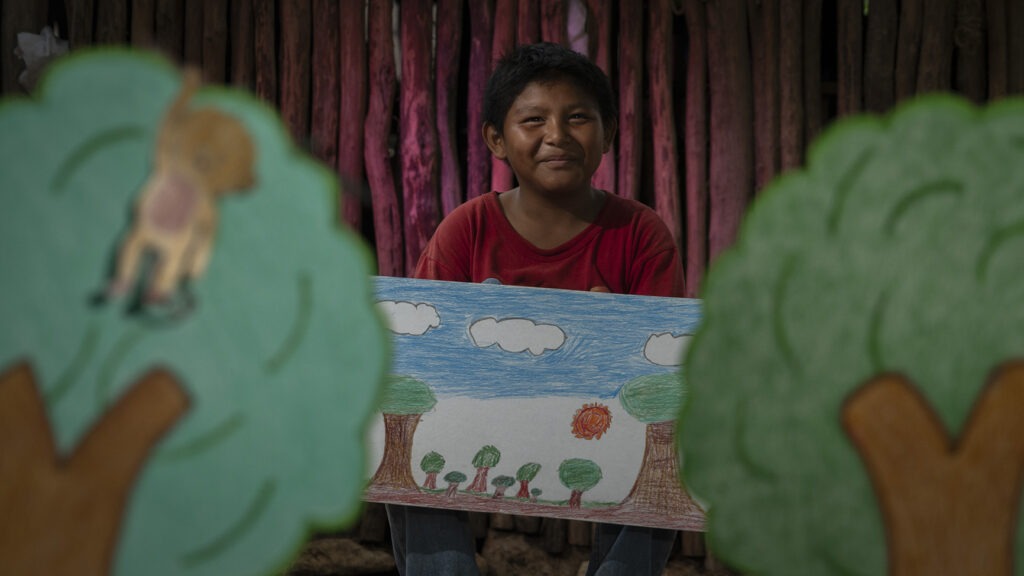
Fredy likes to go to the cornfields; he knows a lot about different varieties of corn and other native seeds. His parents are teaching him about the valuable work of the Maya milpa, a complex biocultural productive system supporting basic food production for families in the Maya territory of the Yucatán Peninsula.
In phase two, the children drew the landscape and its characters. In phase three, Didier recorded the children’s voices telling their stories in Mayan. The fourth phase, which is ongoing, consists of applying the “stop motion” technique, photographing the characters in one position, then in another, so that when the frames are joined, they seem to come to life. Once it is ready, they will upload them to the Yucatec Mayan Language and Culture YouTube channel. The “In waalak’ peek’” video is there, with the song composed by Wilfrido Dzul and performed by Didier, who, as in his time as Bombazo Musical, sings and harmonizes with his guitar. It already has 72,000 views.
Didier dreams that his language lives on, that people hear it, think in it, and can exist through it. He dreams that his language will weave stories between grandparents and childhood that are present in places where it is not commonly read or heard, such as the Internet.
Kopchén: Register a nightingale to save the Mayan language
Carlitos stops talking and listens. Noticing this, his brother and father imitate him, and the house falls silent. It is a typical Maya hut: spacious, with a carefully flattened dirt floor, a woven palm roof and wooden walls through which the fresh air, ambient noise and the sun’s rays shine, illuminating Carlitos’s face as he attentively listens to the song of the birds around us.
“The one in the back is a nightingale,” Carlitos certifies. Carlos Manuel Kumul Chablé is 13 years old. He is robust and has slanted eyes and messy hair. He is participating in another Mayan language rescue project, which began with basic writing workshops but has had such an impact that it has expanded. The project now includes, among other things, an audiobook in Mayan about little birds from the community where it takes place: Kopchén, in Felipe Carrillo Puerto, Quintana Roo.
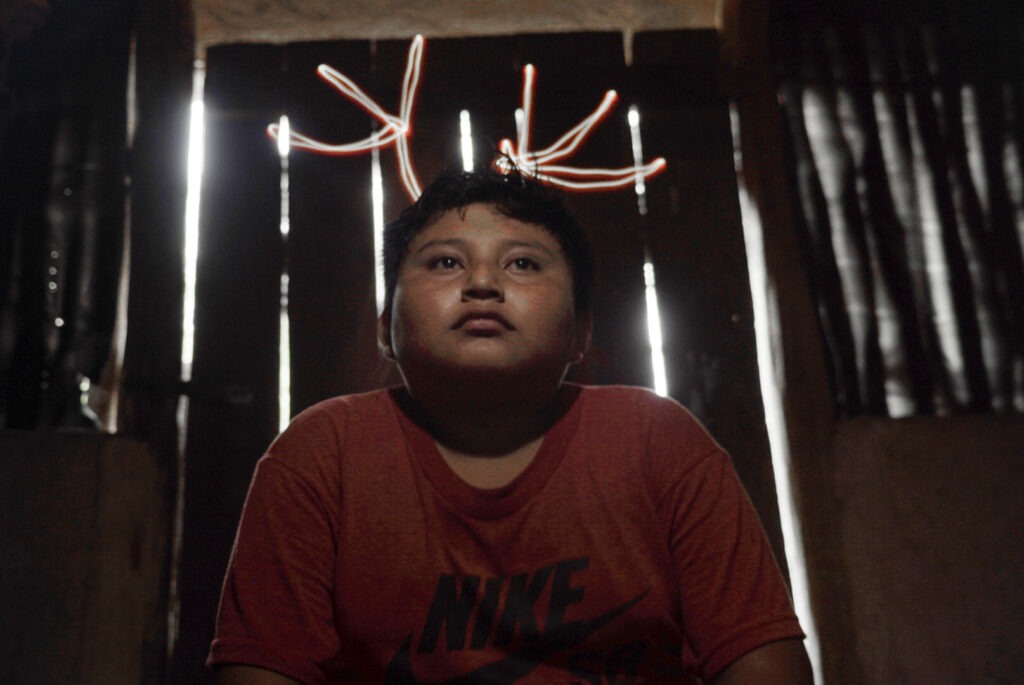
Kilian personifies a deer, called ‘kéej’ in Maya.
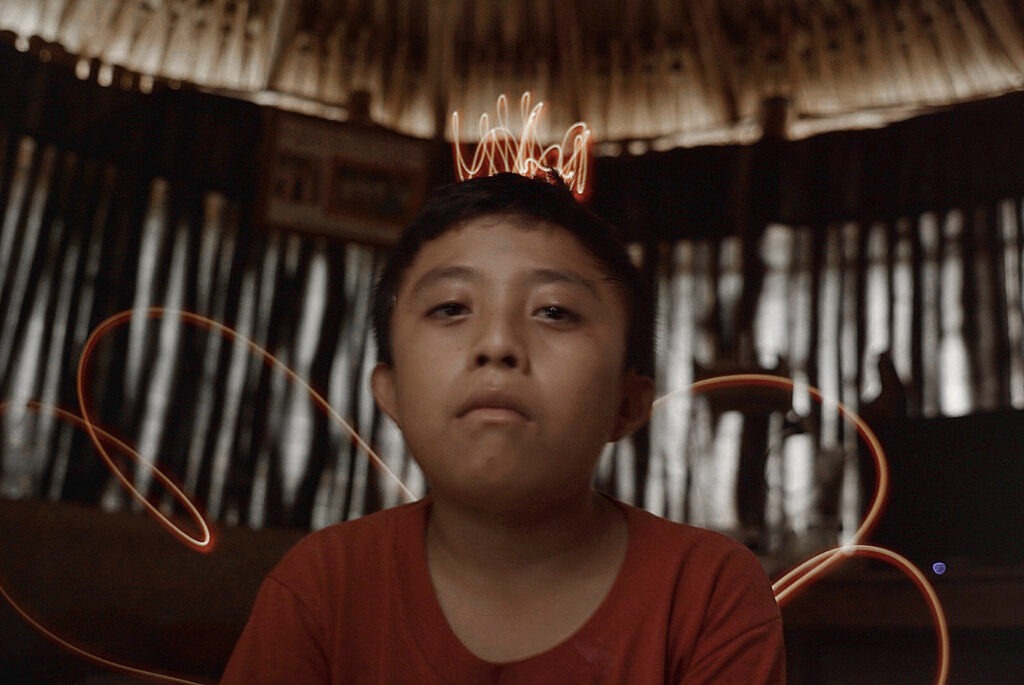
José Miguel is a great bird connoisseur. He personifies a Chujum, that is, a woodpecker.
Siblings Carlos and José Miguel Kumul Chablé, ages 13 and 12, have a good ear for identifying birds, because they are used to them. Kopchén is surrounded by the Maya jungle with its abundant biodiversity. They have also learned to identify bird songs when they go with their dad to collect vegetables in the farmland.
Kopchén is a rural town 40 kilometers from Carrillo Puerto and has a population that is 80% Mayan-speaking – much higher than the regional average. Rodrigo Petatillo, 31, a doctoral student in the Indo-American Linguistics program at the Center for Higher Research and Study in Social Anthropology, was born here.
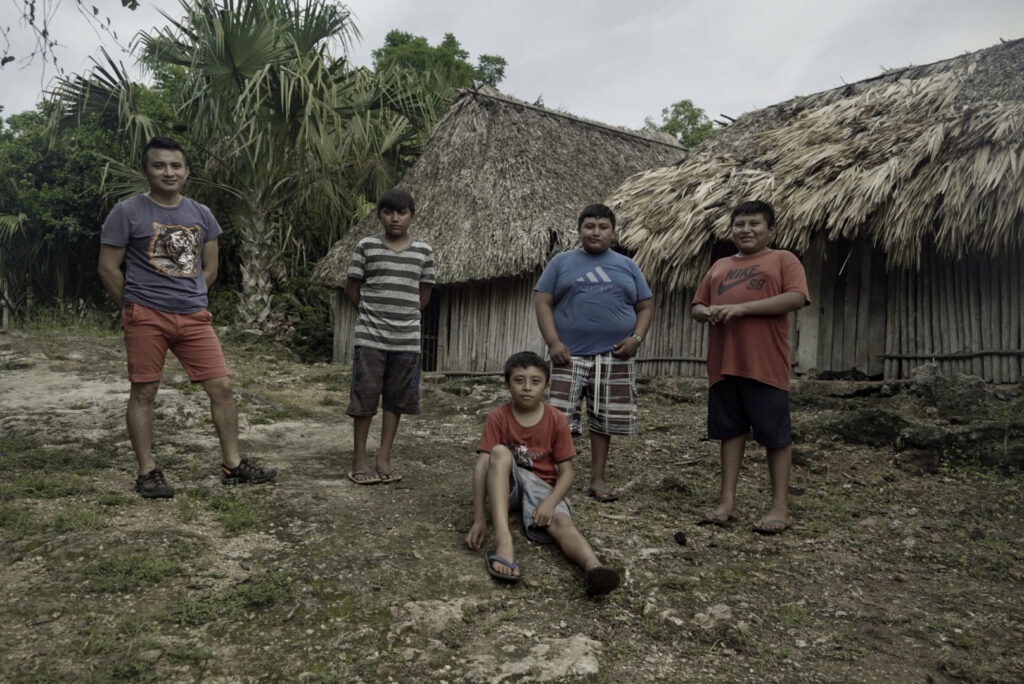
Rodrigo, José Miguel, Dylan, Carlos Manuel, and Kilian are part of the Rising Voices project to revitalize Maayat’aan.
Like Didier, Petatillo was selected by Rising Voices to revitalize Maayat’aan. He proposed creating video capsules in Mayan for distribution on social media. He worked with 17 kids and teens, whom he taught to use technological and digital tools to make recordings, transcribe audio files, translate them and subtitle them in Spanish and English. The videos include vocabularies, everyday expressions, adjectives and even tongue twisters.
“Yaan uje’ yúuyum yáanal ya’, yáanal ya’ yaan uje’ yúuyum,” says Carlitos in one of the 12 capsules. It can be translated as, “There is an oriole egg under the sapodilla, under the sapodilla there is an oriole egg.” The Moctezuma Oriole is listed in Official Mexican Standard NOM-059 as a bird facing the risk of extinction. Both bird and Mayan language are linked by a common threat: being reduced to probable extinction.
In Quintana Roo, the Mayan population that speaks the language is smaller than in Yucatán and is in decline. According to the INEGI, 16.7% of the state population spoke the language in 2010, dropping to 11.6% by 2020. And the vast majority of those who speak it do not write it, which makes it impossible to leave a written record of their stories, says Petatillo.
According to José Ángel Koyoc Kú, a historian specializing in linguistic revitalization strategies, this decrease can be explained, in part, by the fact that there are no new speakers of the language: “There are places in the region where the Mayan speakers are only adults, the older ones.” The fact that children stop speaking it is an alarming and serious sign of the language disappearing, he says. Furthermore, Yucatán has no exclusive spaces where only Mayan can be spoken, so people can live speaking Spanish or English, rather than only Mayan. “At the rate we are going, the Mayan language could disappear in two or three generations,” says Koyoc.
Didier, Petatillo and Koyoc are a generation that grew up between Spanish and Mayan, although the former was predominant in their lives. In the following generations, the children working on their projects only speak Spanish. Both were affected by discrimination against Indigenous Mayan speakers, forced Hispanicization in schools, and policies of whitening, exclusion, segregation, marginalization and racialization that kept the Mayan and 68 other Indigenous languages of Mexico on the brink of oblivion.
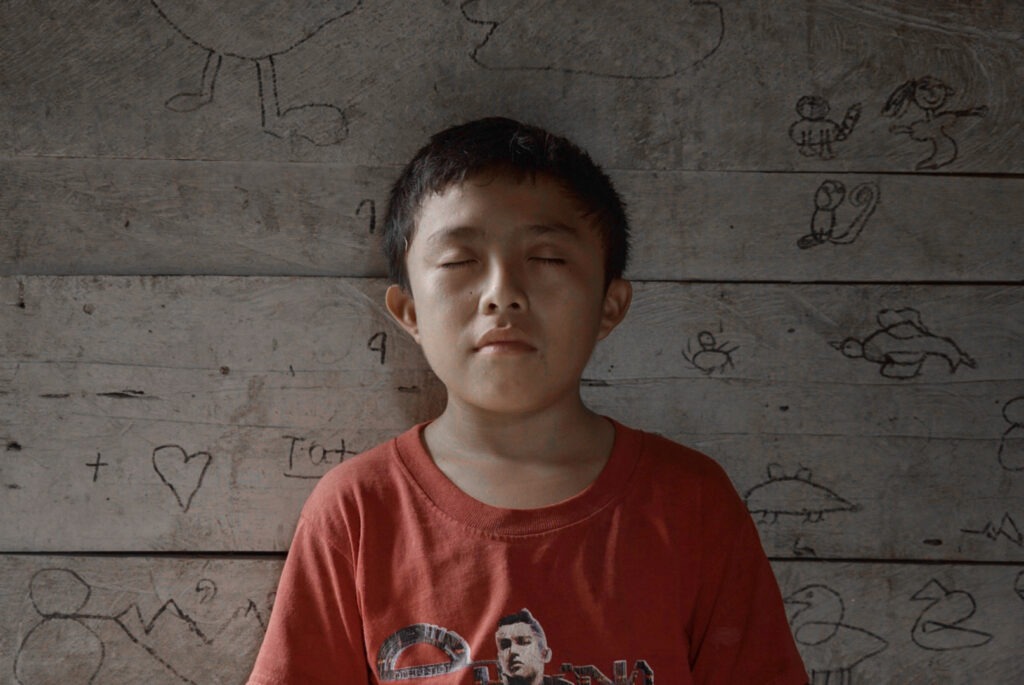
Dylan shares that the Mayan word for dreaming is ‘náay,’ and the dream of longing for something is ‘ts’íibol.’
Petatillo blames the educational system in Kopchén for the students’ lack of reading and writing skills in Mayan. In classrooms, teaching is limited to Spanish; in fact, speaking the Indigenous language is grounds for punishment. “When they spoke Mayan in the telesecundaria (distance education program), they were punished by being told they could not take their recess and had to clean the classroom or the bathroom. They were even struck on their heads – the teacher’s indication that they were stupid. This occurs because the teachers do not speak Mayan, and they have a different vision and a lack of interest regarding Mayan,” he explains.
However, Petatillo clarifies that contact between Mayan with other languages seems beneficial in keeping it alive and revitalizing it. In his bachelor’s thesis, he demonstrated that the Mayan that people speak in Kopchén includes dozens of terms and words borrowed from Spanish. For example, the word gossip, which did not exist in the ancient language, was Mayanized as chiisme.
Petatillo also taught a Mayan reading and writing workshop. He believes that for every child literate in this language and trained in digital tools, there will be someone who transmits knowledge to other children and thus forms a network of activists. Today, there are 17 children interested in becoming literate in Mayan, and two of them are excited to record the songs and names of birds in Mayan in a public audiobook.
“We also birdwatch with a biologist to connect with conservation projects. Many possibilities open up,” Petatillo imagines. Petatillo’s biggest dream is to build the Mayan House of Studies in Kopchén as a space where people learn to write in the language, where children are motivated to write a poem or a novel, and a place to record the oriole or nightingale’s song.
Preserving the language prompted one dream and another, and another.
***
This report is part of a series by Periodistas de a Pie, funded by the W.K. Kellogg Foundation. Photos by Robin Canul.

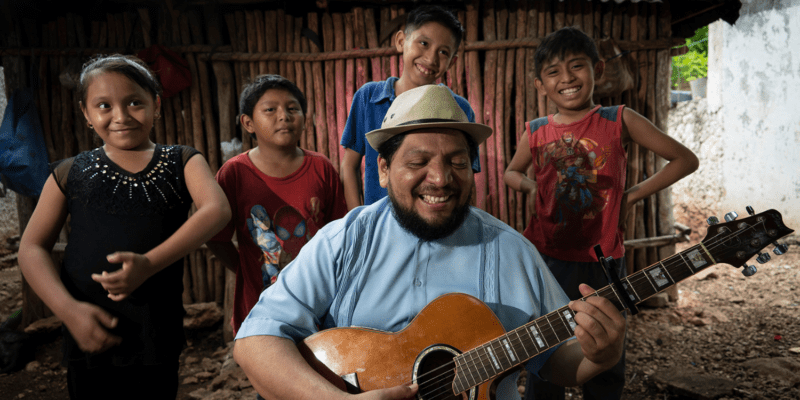
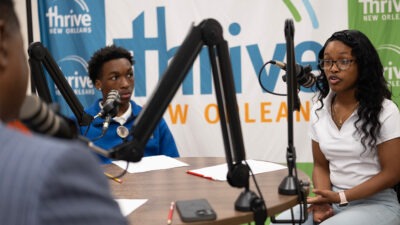

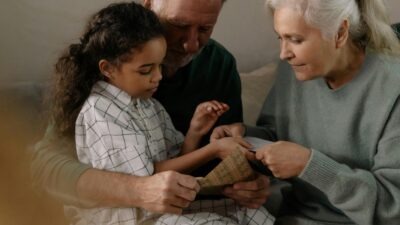

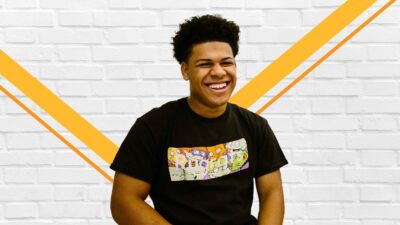

Comments